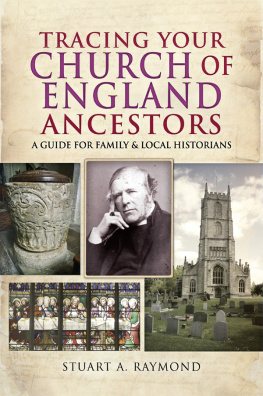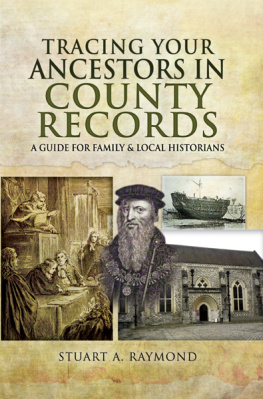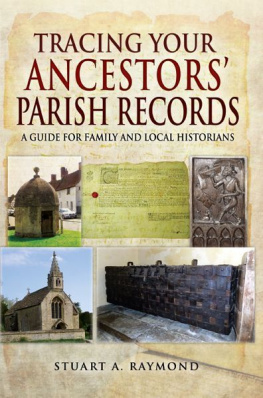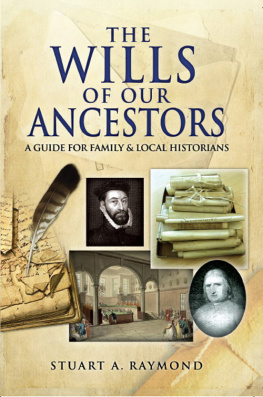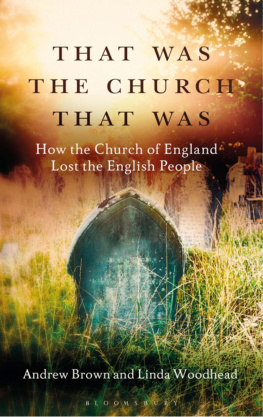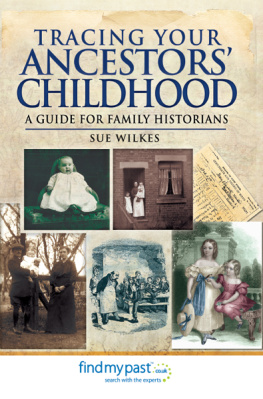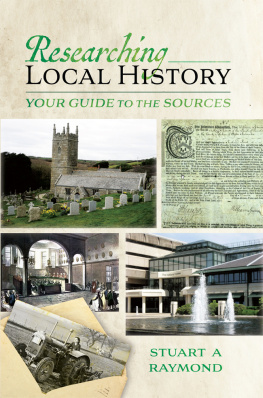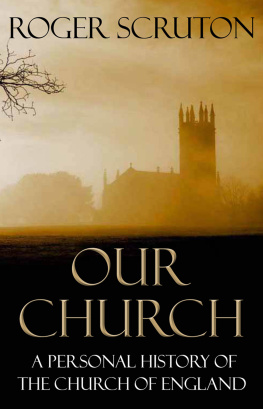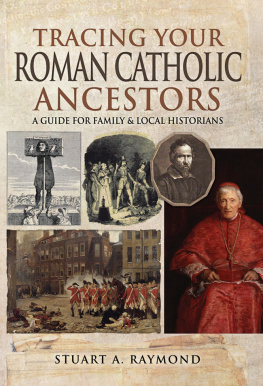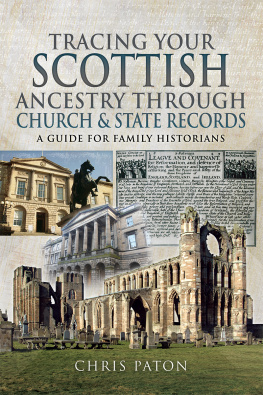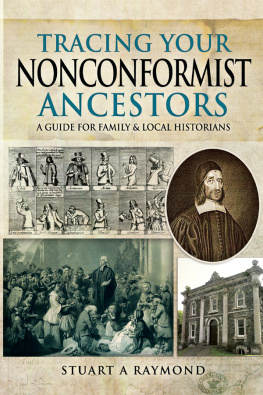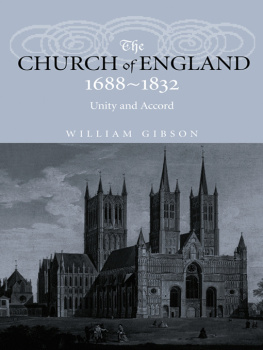
TRACING YOUR CHURCH OF ENGLAND ANCESTORS
A Guide for Family and Local Historians
Stuart A. Raymond
First published in Great Britain in 2017
PEN & SWORD FAMILY HISTORY
an imprint of
Pen & Sword Books Ltd
47 Church Street
Barnsley
South Yorkshire
S70 2AS
Copyright Stuart A. Raymond, 2017
ISBN 978 1 47389 064 0
eISBN: 978 1 47389 066 4
Mobi ISBN: 978 1 47389 065 7
The right of Stuart A. Raymond to be identified as Author of the Work has been asserted by him in accordance with the Copyright, Designs and Patents Act 1988.
A CIP catalogue record for this book is available from the British Library.
All rights reserved. No part of this book may be reproduced or transmitted in any form or by any means, electronic or mechanical including photocopying, recording or by any information storage and retrieval system, without permission from the Publisher in writing.
Pen & Sword Books Ltd incorporates the imprints of Pen & Sword Archaeology, Atlas, Aviation, Battleground, Discovery, Family History, History, Maritime, Military, Naval, Politics, Railways, Select, Social History, Transport, True Crime, Claymore Press, Frontline Books, Leo Cooper, Praetorian Press, Remember When, Seaforth Publishing and Wharncliffe.
For a complete list of Pen & Sword titles please contact
PEN & SWORD BOOKS LTD
47 Church Street, Barnsley, South Yorkshire, S70 2AS, England
E-mail:
Website: www.pen-and-sword.co.uk
ACKNOWLEDGEMENTS
My major debt in writing this book is to the authors whose works I have cited. I would also like to thank Marjorie for occasionally dragging me away from the computer. I am grateful to the librarians of Trowbridge, Sarum College and the Bodleian Library for their assistance. Simon Fowler, and one of my former Pharos students, have both made useful comments and saved me from errors. Any that remain are my responsibility, and I would be grateful if they could be brought to my attention.
Stuart A. Raymond
INTRODUCTION
Until the late seventeenth century, every English man and woman was a member of the Church of England. Legally, that continued to be the case for several centuries, although in practice Nonconformists and Roman Catholics denied their membership. Anglican priests, even today, recognize that they have an obligation to serve everyone in their parishes. It follows that everyone with English ancestors, at least in the nineteenth century and earlier, can claim Anglican ancestors.
This book explains how to trace Anglican ancestors. It is hoped that local historians will also find it useful. The documentary needs of the latter are very similar to those of the family historian, but are sometimes somewhat wider. Here, we are primarily concerned with records created within dioceses and parishes, although other records are mentioned where appropriate. Readers are assumed to have a basic knowledge of major sources, such as the civil registers of births, marriages and deaths, and the census returns. Two other basic sources parish registers of baptisms, marriages and burials, and probate records are actually records created by the Church of England, so are discussed here. The Church of England, incidentally, was the established church of England and Wales, and also of Ireland, but not of Scotland. The records of both Scotland and Ireland are not within the scope of this book.
We begin by placing the records that we need to consult in the context of the institution which created them. is solely devoted to the task of tracing clergymen, whose careers can frequently be traced in much more detail than is possible for most of the laity.
There are many terms used in this book which are peculiar to the Church of England. This jargon is generally explained when it is first mentioned. However, for a brief overview, see:
Church Jargon
www.churchsociety.org/issues_new/churchlocal/iss_churchlocal_jargon.asp
The aim of this book is to suggest which sources might tell you something about your parish or your ancestors. As you read it, make a note of the various sources which might reveal some information about specific ancestors and follow them up either online or in a record office. Happy hunting!
Chapter 1
THE HISTORY OF THE CHURCH OF ENGLAND
After the crucifixion of Jesus, the message of the Gospel spread throughout the world. Discounting the myth that Joseph of Arimathea visited Glastonbury, it took perhaps two or three hundred years before it reached the island of Britain. The Church of England traces its ancestry back to two sources. The Celtic church flourished for several centuries before the Anglo-Saxon invasion. When Augustine was sent from Rome to evangelize the Anglo-Saxons in 697, he found that Celtic Christians were still active in the North and West, and were conducting their own missions in places like Lindisfarne and Iona.
Roman Catholic and Celtic traditions were different. It took half a century to meld them together. By the latter half of the eighth century, however, they had formed a unified body. The Church of England was not to be divided by doctrinal controversy again until the ideas of John Wycliffe prompted the Lollard heresy to break out at the end of the fourteenth century.
Lollardy was uncharacteristic, and was quickly repressed, although it is possible that remnants survived to see some Wycliffite teachings adopted by early sixteenth-century Continental reformers, such as Martin Luther and John Calvin. Generally, however, early Tudor Englishmen were firmly attached to the Church of Rome. That attachment was strengthened by the imminence of death, which, in an age without modern medicine, was a constant threat. So was Hell. The great paintings of doom which could be seen over the chancel arch in many parish churches, one of which is still viewable at St. Thomass church in Salisbury, illustrated what was thought to happen after death. God was depicted sitting in judgement. Demons stood ready to seize the damned, and cast them down into Hell, which was graphically portrayed as the gaping mouth of a monster. On the other hand, angels stood ready to escort those saved by the blood of Christ into Heaven. Salvation depended on the sacrifice of Christ, mediated through the church, the body of Christ. The church offered consolation in death, a means to shorten the time to be spent in Purgatory, and a gateway to eternal life.
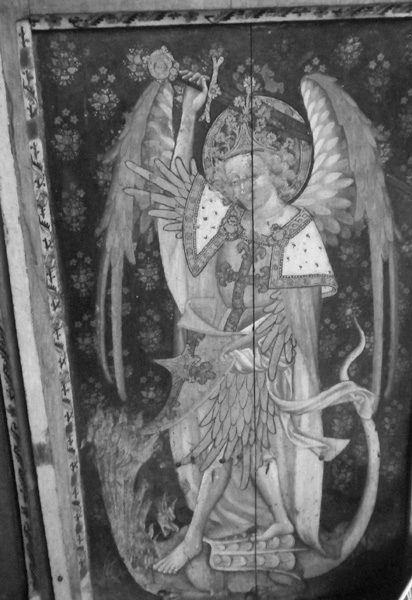
St Michael slaying the dragon at Ranworth in Norfolk.
Englishmen exercised a vibrant faith in the goodness of God, and in the power of the Resurrection. Their faith was expressed through the church, and through its services. The evidence of that faith is still all around us in the English landscape. It can be seen by anyone who cares to walk more than a mile or two in the English countryside: the landscape is full of fifteenth- and sixteenth-century church towers, which are rarely more than three or four miles apart. A lot of time, money, and effort went into their construction.
Protestants, however, thought that the Roman Church was full of abuses, notably the sale of indulgences, and the growth of the chantry system, both of which were claimed to reduce the time to be spent in Purgatory. They insisted that the reverence paid to images was idolatrous, and argued that the Bible alone was the guide to faith.

